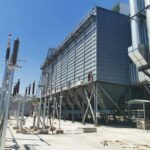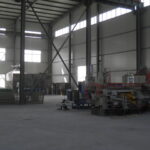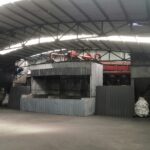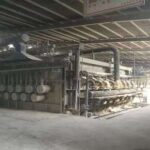In the last article “Feeding Calcium Cored Wire Into Ladle”, we have introduced some knowledge about calcium treatment process simply, however, some knowledge we introduced vaguely. In this article and subsequent article, we will introduce applications of this process during steelmaking in detail. Firstly, we introduce definition and theoretical basis of calcium treatment simply.
Content
What is calcium treatment?
Calcium treatment process is a kind of methods that molten steel refining, it developed from 1970s gradually. Calcium can turn high melting point Al2O3 inclusions into low melting point calcium aluminate in molten steel, makes inclusions bigger, come-up easily and removed. And then, improve molten steel cleanliness. Thus, it used in secondary refining technique widely. At present, it has become major method in molten steel refining.
Theoretical basis of calcium treatment
Generally speaking, many indexes can measure steel cleanliness. Among these indexes, the most important judging symbol is oxygen content in steel. It is inverse proportion relation between oxygen content and steel cleanliness, it means lower oxygen content, higher steel cleanliness, vice versa. Many techniques can improve the steel cleanliness, Al deoxidizing technique is an including technique. It can reduce oxygen content in molten steel, it makes high melting point Al2O3(2052℃) come-up and removed by argon blowing, stirring or other methods. As a result of total of oxygen content decreasing, it achieves the goal that improve steel cleanliness.
Calcium can modify inclusions
Evolution of inclusions
Inclusions have many types during the whole calcium treatment process.
Before calcium treatment process, major inclusion in steel is Al2O3, also includes a certain amount of MgO·Al2O3, because a little Mg can coagulate with Al2O3 pretty easily and generates MgO·Al2O3. This is the reason why it includes MgO·Al2O3 inclusion.
At the moment of adding calcium, calcium doesn’t diffuse in liquid steel immediately, thus calcium concentration is higher in parts of liquid steel than other position and generates CaS inclusion, Al2O3 in steel turned into CaO·Al2O3, MgO·Al2O3 turned into CaO·Al2O3 or CaO·MgO·Al2O3. As a consequence of non-ideal diffusion condition of calcium and deficiency of calcium remains in steel, it caused Al2O3 and MgO·Al2O3 inclusions still exist.
As feeding wire time goes by, calcium content in liquid steel increases gradually, most of Al2O3 and MgO·Al2O3 turned into CaO·Al2O3 and CaO·MgO·Al2O3.
As prolonged of time, CaO·Al2O3 and CaO·MgO·Al2O3 are major inclusions in finished product.
Figure 1 is route schematic map of inclusion turning during calcium treatment process.

Fig. 1 Evolution of inclusions in steel during calcium treatment process
Calcium can modify Al2O3 inclusions
Analyzing Figure 2, we can see clearly that among calcium aluminates generated by calcium and Al2O3 inclusions, melting point of C12·A7 and C3·A(1455℃, 1535℃) is liquid under steel refining temperature.
Ito and other researchers find that calcium can turn Al2O3 inclusions outside-in by many experiments and calculations.

Fig. 2 CaO-Al2O3 binary diagram
Calcium can modify MgO·Al2O3 inclusions
Many research results indicated that most of Al2O3 inclusions have coagulated with Mg and generated MgO·Al2O3 before calcium treatment process in Al deoxidizing steel.
Hamoen and other researchers think that Al2O3 can be turned into MgO·Al2O3 in low carbon killed steel during LF refining process, because of redox reaction between furnace slags and liquid steel. After calcium treatment process, inclusions turned into MgO·CaO·Al2O3.
Itoh and others deduced thermodynamic equation that calcium turned MgO·Al2O3 process under 1873K, laid the foundation for subsequent relevant researches.
Thermodynamic equation is as below:
Ca + 2MgO·Al2O3 = 2Mg + O + CaO·2Al2O3(s)
Calcium can modify sulphide inclusions
Ca is No. 20 element in periodic table of chemical element and No. 2 element in metal activity sequence table. From above 2 points, we can see that calcium is pretty reactive. This causes it combines with sulphur extremely easily and generates CaS, at the same time, it can restrain MnS generation process during liquid steel solidification. And turns it into spherical inclusion —— CaS that is difficult to deform. Equation for denaturing MnS inclusions is as follows:
[Ca] + (MnS) = [Mn] + CaS
In actual perform process, sulphide often separates out from calcium aluminate. Based on this, some researchers put forward view that Ca/S has a important effect on inclusions’ compositions.
| Ca/S | Nucleus | Surface |
|---|---|---|
| 0 ~ 0.2 | Al2O3 | MnS |
| 0.2 ~ 0.5 | CxAy | MnS |
| 0.5 ~ 0.7 | CxAy | (Ca, Mn)S |
| 1 ~ 2 | CxAy | CaS |
Table 1 Ca/S effects on nucleus and surface
As above table, we can see that calcium not only modifies Al2O3, but also displace Mn from MnS with Ca/S ratio increases gradually. While when Ca/S ratio reaches to 1-2, calcium displaces Mn completely and generates CaS.
From above analysis, adding calcium more or less effects result of calcium treatment process directly.
Generally speaking, steel plants should desulphurize until sulphur content reaches to lower level before calcium treatment process, otherwise, generates a lot of CaS to clog the nozzle during process.
If you have any questions or needs, please contact us without any hesitation. We will revert as soon as possible.






